6 Differences Between Leopard Gecko And Bearded Dragon
Have you finally considered having a reptile as a pet but cannot decide which among the popular options you should choose? Bearded dragons and leopard geckos are two of the highly recommended lizards for beginners like you! But between the two, which should you pick?
Though both lizards are beginner-friendly pets, leopard geckos and bearded dragons have six notable differences to consider:
- appearance
- diet
- behavior
- handling
- enclosure
- location
Stay with us as we help you come up with a decision.
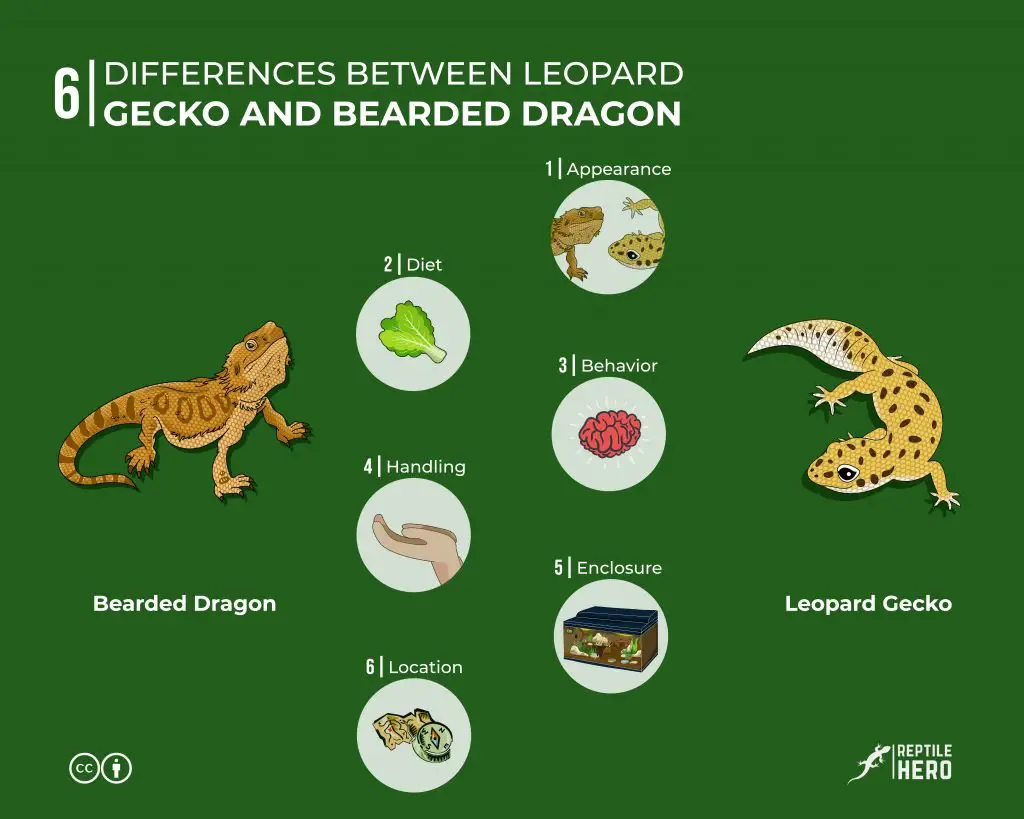
Leopard vs. Bearded: Which One to pick?
Several lizard species are increasing interest in befitting as pets around the globe. Though they are widely considered exotic pets, lizards like bearded dragons (beardies) and leopard geckos (leos) have become famous beginner’s pets after years of captive-breeding. To help you decide better which of the two you should have, you should know these six category differences.
Physical Differences
With a surge in the popularity of lizards as pets, breeders are rampant online. With the diversity of what they are selling, you might have difficulty deciding which of the beardies or leos you should get.
With both lizards exhibiting unique physical characteristics, here are five notable physical differences you have to know to help you arrive at a conclusion.
Size and Weight
When choosing a pet, you always look into its possible length and weight upon maturity. Sometimes, its size is all that even matters for you. Before pondering between a beardie or a leo, below is a table of insights concerning the differences in size and weight between the two you should know.
| Difference | Bearded Dragon | Leopard Gecko |
|---|---|---|
| Average adult size, inches | 16 – 24 | 6 – 9 |
| Average adult weight, grams | 300 – 550 | 50 – 80 |
| Lifespan in captivity, years | 10 + | 20 + |
Appearance
Beardies
The bearded dragons’ anatomy shows a wedge-shaped head and flattened body with spikes running from the sides of the head and throat. These spikes are also on their backs and sides. Interestingly, their tail is almost as long as their body.
As their name suggests, they are called as such because of the lizard’s ability to unfurl the skin under their chin or throat region when threatened or disturbed, manifesting a “beard.” Furthermore, their flattened body becomes more pronounced when alarmed.
With these physical characteristics, these captive-bred lizards are genetically and visually the closest to the bearded dragons in the wild.
Here is a short clip showing the puffing of a beardie’s beard.
Leos
The leopard gecko’s framework exhibits a small triangular-shaped head with a long, wart-like textured body and a thick, segmented tail. Their legs are slender that is anteriorly white all over, with long claws extending outwardly.
As their name suggests, their back is covered with thick horizontal bands of leopard-like spots. However, under their bumpy body is a smooth underbelly with no distinguishing marks.
Some people do not prefer their textured backs, so they breed new morphs to remove the bumps. So, you may find one with smooth skin, commonly known as scaleless.
Color
Beardies
In the wild, beardies are often imagined as sandy-colored reptiles ranging from brown, tan, and yellow shades. As uninteresting as it sounds for some of you who may prefer quirky and upbeat colors, these boring shades actually help them avoid larger predators in nature.
In captivity, many generations of selective breeding have greatly influenced the color variations of captive-bred beardies. Aside from the dull colors between browns and yellows, the following colors are available for you to choose from:
- red
- orange
- yellow
- white
- gray
- silver
- black
- green
- blue
- violet
As your beardie ages, you should take note that its colors and patterns—if present—are bound to change. So, fret not if your lizard slightly alters its appearance over time.
Inherent colors are not the only ones responsible for the complexion of your beardie. Visual traits after selectively breeding are called morphs. These may have color features that could also be responsible for how a beardie would look.
- hypomelanistic
- translucent
- zero
- witblits
- wero
- paradox
Leos
In the wild, leos are depicted as rocky geckos with bland and dull visual features. Though you might think it is unexciting to own a pet like this, these colors actually help camouflage in their surroundings from predators.
Fortunately, years of captive-breeding have resulted in a variety of colors and patterns you might fancy. Apart from the neutral colors in the wild, leo morphs with the following visual traits are available for you to consider:
- albino
- hypomelanistic
- tangerine
- patternless
- carrot-topped
- carrot-tailed
- blizzard
- jungle
- melanistic
- giant
- supergiant
Aside from their vibrant colors and morph features, varying black or chocolate patterns also occur in captive-bred leos:
- rosettes, chain-rosettes, or solid spots
- regular or irregularly shaped stripes
- uniform or uneven blotching patches
Eyes
Beardies
What sets beardies apart from leos is their third eye called Parietal, Pineal, or Solar Eye.
Though it does not primarily function to visually see around like their two yellowish eyes, the parietal eye functions as a photosensory organ that:
- detects attacks from above
- performs thermoregulation
- senses changes in light
- triggers hormone production
Leos
Leos have light-sensitive eyes that have moveable eyelids which perfectly close like yours.
Breeders have also been fond of selectively breeding eye features of leos. For example, aside from the typically slit pupils, other mutations which have been deliberately produced include:
- the “eclipsed pupil,” where it is completely filled in solid black or red color
- the “snake-eyes,” where there are partial leaks of the pupil into the iris
- the “marble-eye,” where there are spots within the eye’s iris
Legs
Beardies
Beardies have four limbs with five toes on each—one big toe and four smaller ones. The toes are either curved slightly downward toward the ground or relatively straight, whichever orientation would help the lizard take a firmer grip while staying balanced. Moreover, each toe also has a toenail that would curl downward when they grow long.
In the wild, beardies are deemed ‘semi-arboreal,’ meaning they could climb and spend the day on treetops or climb off the ground. In captivity, on the other hand, they may spend more time on the floor, depending on how the enclosure is landscaped.
Leos
Leos have four limbs with clawed toes. Their legs are shorter than the beardies’ limbs. This feature allows them to be agile and quick when moving around in the shrubs on the forest floor. Meanwhile, their small nails enable them to latch onto twigs and rocks for climbing.
Unfortunately, they have clawed toes that lack the sticky feature found commonly on other gecko species. Hence, they tend to stay more above ground, exploring rocks and logs. Occasionally, they climb on twigs for basking, but not on tank walls like their cousins.
4 Differences in Caring For Bearded Dragon and Leopard Gecko
Despite being very common reptiles, a leopard gecko and bearded dragon require different care and attention: Indeed, their 1) diet requirements, 2) behavior 3) handling, and 4) enclosure are different.
Dietary Requirements
Originating from different continents in the wild, you should expect beardies and leos to have contrasting food demands despite both loving arid environmental conditions.
Summarized in the table below are their nutritional preferences you should meet.
| Difference | Bearded Dragon | Leopard Gecko |
|---|---|---|
| Classification | omnivore | carnivore (specifically insectivore) |
| Food | 80% gut-loaded insects, including crickets, mealworms, King worms, earthworms, and cockroaches, and 20% mixed green leafy vegetables and a little fruit | live insects, including crickets, small mealworms, waxworms, and dubia roaches |
| Water | fresh, clean, chlorine-free water | fresh, clean, chlorine-free water |
| Supplements | calcium supplement daily and a multivitamin supplement once or twice a week | calcium supplement daily and a multivitamin supplement once or twice a week |
Behavioral Differences
Just like how you are different from me, beardies and leos have unique behaviors specific to them. Since they are two lizards of distinct species, you must be acquainted with how well they behave as pets to better come up with a decision.
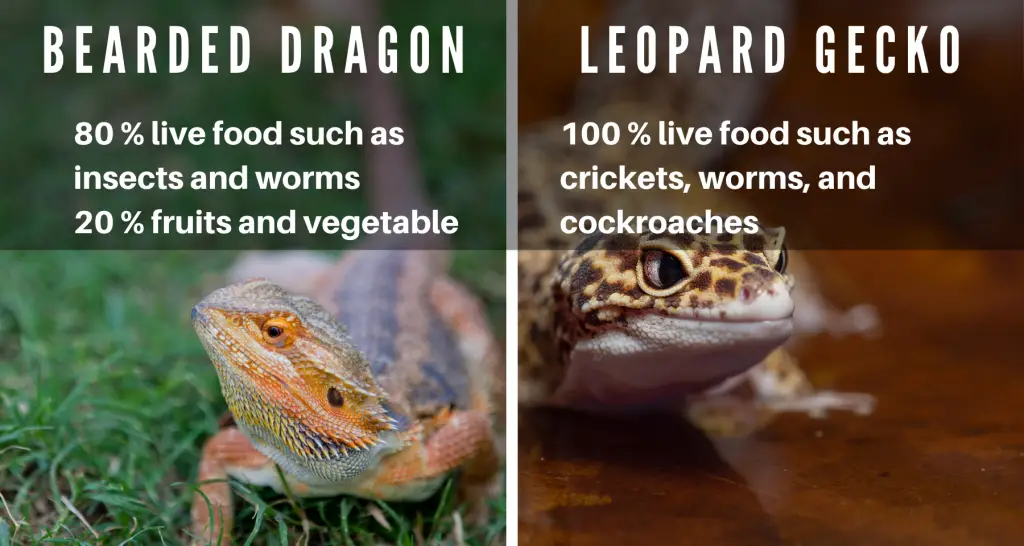
Beardies
If you are looking for a calm reptile with a fun demeanor, beardies might be just for you. They tend to be mellow and submissive lizards, even if you found it in the wild.
If you can provide it with a safer and larger enclosure than what they require, beardies would surely love it as they are often known to be curious. They would definitely enjoy exploring around.
Furthermore, they often enjoy human company, especially the adults, as hatchlings and juveniles can be skittish at times. So, you would not have a hard time choosing which in the store prefers your presence best.
Besides their appreciation to your company, they would love you to pick them up and handle them only when they already got used to you. Hence, you could quickly build a strong foundation between you and your lizard, making it a great pet!
Leos
If you prefer a smaller reptile, but with a slightly similar personality as beardies, leos can be for you. Though they are not genuinely clumsy per se, their smaller framework tends to feed you this idea because of their gentler disposition compared to larger lizards like the beardies.
When leos are most active at night, you could observe them exploring their surroundings at their own slow pace. They seem to also equally move around like the beardies. Unless you somehow own a nervous adult leo or a fidgety young one, they can manage your handling as long as they are already comfortable with you. They tend to just sit on your hand and rest as you take them.
Even though handling is not a big issue and biting is rare, you should keep it bare minimum since overhandling can cause stress. Furthermore, it is noteworthy never to grab by the tail, or else they might drop it!
What sets them apart from most reptiles is their clean personality. They exclusively use one spot in the tank as a bathroom, which makes cleaning less demanding for you.
Handling Needs
As both lizards appreciate your handling, you must be aware that they are not handled the same way, especially since their physical features and behavior are different.
Thus, you need to know how different they are handled so you can choose the reptile that suits you better.
Beardies
Even though you know that beardies enjoy your handling and company, you still need to correctly pick it up to avoid stress and struggles.
When picking up your beardie, you can utilize the following tips:
- Place your hand under its abdomen.
- Scoop it up gently using both hands.
- Curve your fingers around its abdomen.
- Allow it to softly lay on your palm.
- Start with a 10-minute handling session.
- Keep this up until it is comfortable with you.
However, you should note that you should not attempt to pick it up when the lizard backs away or threatens to bite. Leave it alone in the meantime and wait for another opportunity.
Leos
As leos can manage minimal handling from you, it is best to know how you could pick it up correctly. To emphasize, you must always remember never to pick it up by the tail, or else it will fall off!
When handling your leo, make sure to use the tips below:
- Start by placing a flat hand down.
- Ease it onto your palm.
- Hold it with a flat hand while supporting its legs and tail.
- Stroll with it slowly.
- Start with a five-minute handling session.
- Continue until it is comfortable.
If you feel that it is insecure, it will make barking sounds and wag its tail. In case this happens, you better return it to the tank so as not to cause further stress.
Another thing to remember is you should never run while handling your leo. Making fast movements significantly induces stress to the gecko, which could cut its tail off.
Enclosure Demands
While both lizards love the arid conditions of the deserts, grasslands, and woodlands, housing the two species as pets in captivity requires different setups. It needs to perfectly mimic their natural habitats.
To help you spot the differences in their enclosure requirements, see the table below.
| Set up | Bearded Dragon | Leopard Gecko |
|---|---|---|
| Tank Size | at least a 120-gallon tank | at least a 20-gallon tank |
| Tank Orientation | floor space is more important than height | floor space is more important than height |
| Landscape | must have wide branches, and flat-bottomed, smooth rocks, and boxes for climbing, basking, and hiding | must have a lot of hiding areas under branches, corks, logs around the tank |
| Substrate | must use either a flat newspaper, wrapping paper, or a reptile carpet | must use a combination of paper towel, rough, flat slate pieces, and terrarium carpet |
| Temperature | must have a warm end at 100°F and a cool end at 70°F | must have a basking area at 95°F and a cool-end spot between 78 and 88°F |
| Heat Source | must have an incandescent day bulb for the basking area during daylight hours only while ceramic heater at all hours | must have an under-the-tank heater (UTH) pad |
| Humidity | must maintain humidity below 50% | must maintain humidity below 50% |
| Lighting | must provide 10 to 12 hours of light in a day | must provide 10 to 12 hours of light per day |
| Light Sources | must supply a combination of fluorescent and incandescent light fixtures for visible white light and a UVB bulb with a full spectrum for UV rays | must give a cool-white incandescent basking bulb and a UVB full-spectrum bulb |
Additional Information: Origin in the Wild
Domestication through captive-breeding may have increased their population, specifically as pets. However, beardies and leos still exist in the wild, undomesticated.
Bearded Dragon (Pogona vitticeps)
Origin: Australia
Habitat Region: Scrublands and Woodlands
The Inland Bearded Dragons, natively found in Australia’s arid deserts and woodlands, are where most morphs of captive-bred bearded dragons emerged from [1].
During the day, these diurnal lizards consume much of their time foraging for insects, fruits, flowers, and small lizards and mammals in bushes and trees or basking on top of rocks. When the temperature shoots up, they burrow under the ground for shelter and coolness.
Leopard Gecko (Eublepharis macularius)
Origin: Southern Asia
Habitat Region: Grassland and Desert
Leopard geckos are naturally inhabiting the dry, rocky grasslands and deserts of Afghanistan, India, and Pakistan in Southern Asia, where there are minimal precipitation and sparse vegetation [2].
In the wild, these crepuscular lizards spend much of the day dug up under the ground or hidden under rock crevices from the heat of the sun. From dusk until dawn, they do much of their activities like scouting the area for predators and scavenging for insects and worms.
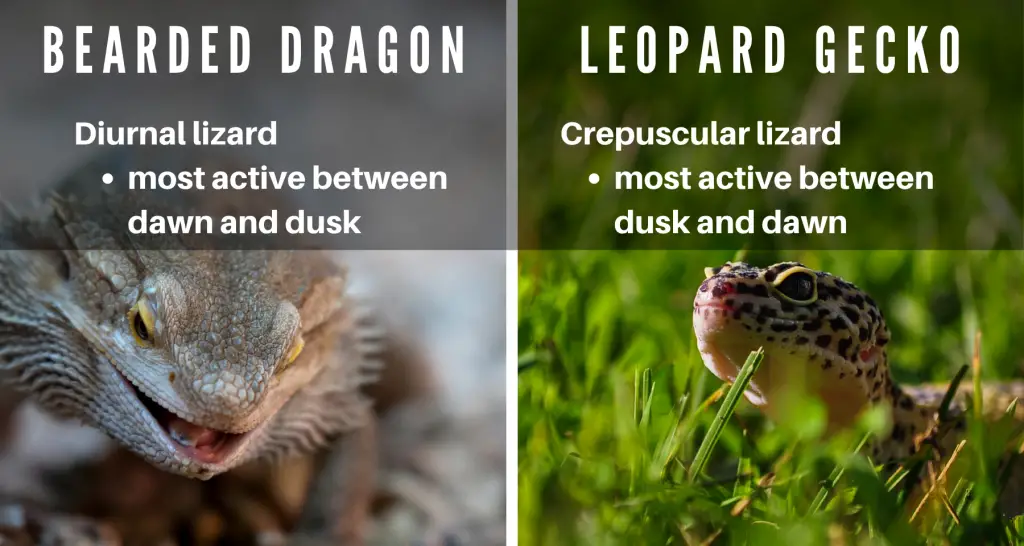
Do Beardies and Leos Get Along?
As both are distinctly beautiful, beardies and leos are undoubtedly two of the most famous reptiles as pets. You might wonder then, “What if I get one of each species and house them together? In that way, I do not need to choose between the two, and they must get along since both are lizards.”
Bearded Dragons and Leopard Geckos must never share an enclosure. This is because of both lizards’ territorial nature that will push each other to fight and injure themselves seriously.
Besides, a beardie generally outgrows and outweighs a leo upon maturity. When the beardie gets way more prominent than the leo, the latter might end up as food for the former sooner or later.
Aside from this possible circumstance, the two’s housing requirements are entirely different in such a way that meeting the two demands is better off separated than put into one. Also, both species may possibly transmit pathogens that are lethal to the other.
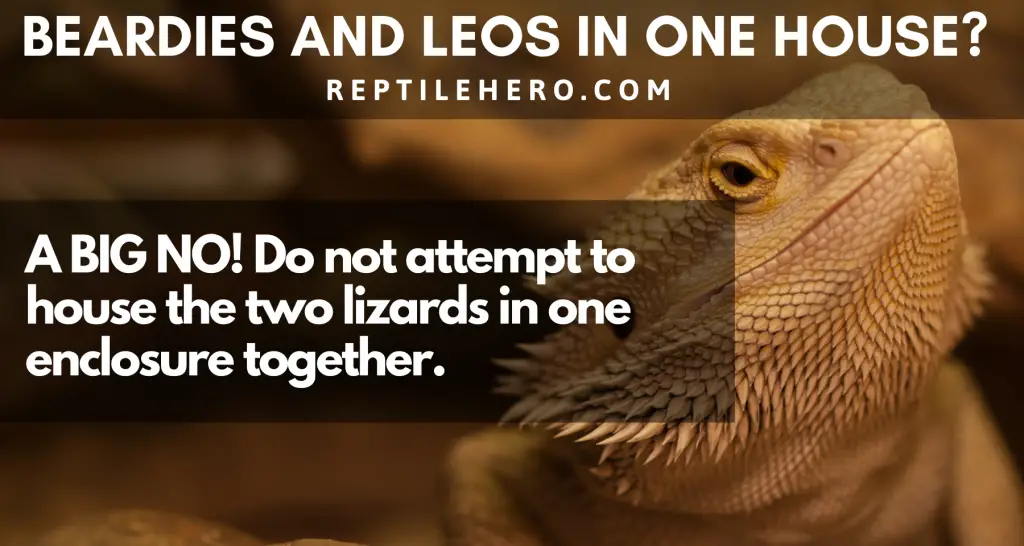
Looking For Another Comparison?
If you are interested to know more about how a leo fares against a crestie instead of a beardie, you might want to read about our previous article on leo vs. crestie by clicking here.
Takeaways
Bearded dragons and leopard geckos love the arid environment of deserts. However, the former is natively found in Australia, while the latter is originally from Southern Asia.
Though both primarily feature neutral colorations in the wild, vibrant bearded dragons and leopard geckos are available in captivity. However, what sets the two physically apart is their apparent size difference.
Bearded dragons need 80% live food–20% fruits and vegetable nutrition, while leopard geckos require a 100% insect diet.
Although both lizards have a calm demeanor, bearded dragons fare better when handled than leopard geckos, as the latter is more prone to stress-induced tail-dropping.
Even though bearded dragons and leopard geckos share their love for arid conditions, both have different unique and specific requirements. The former needs a bigger enclosure, while the latter prefers lower temperatures.
Sources
[2] https://animaldiversity.org/accounts/Eublepharis_macularius/

![Is House Gecko’s Bite Dangerous? [and What To Do]](https://www.reptilehero.com/wp-content/uploads/2022/05/house-lizard-bite-dangerous-cc-768x614.jpg)
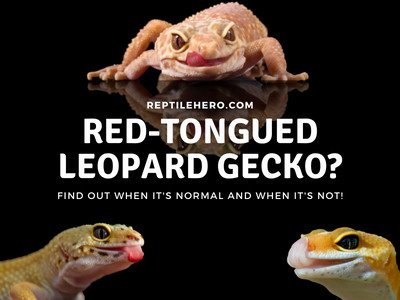
![Can You Train Your Gecko? [5 Tricks It Can Learn Now]](https://www.reptilehero.com/wp-content/uploads/2021/02/Gecko-Training-Infographic-768x614.jpg)
![The 5 Reasons Why Do Your Geckos Jump [and 5 Precautions]](https://www.reptilehero.com/wp-content/uploads/2022/01/why-geckos-jump-cc-768x614.jpg)
![8 Reasons Why Your Gecko Bury Itself? [Crested and Leopard]](https://www.reptilehero.com/wp-content/uploads/2021/02/Gecko-Bury-cc-768x614.jpg)
![Why Is My Gecko’s Poop Black and White? [With Science]](https://www.reptilehero.com/wp-content/uploads/2022/03/gecko-poop-black-white-cc-768x614.jpg)
